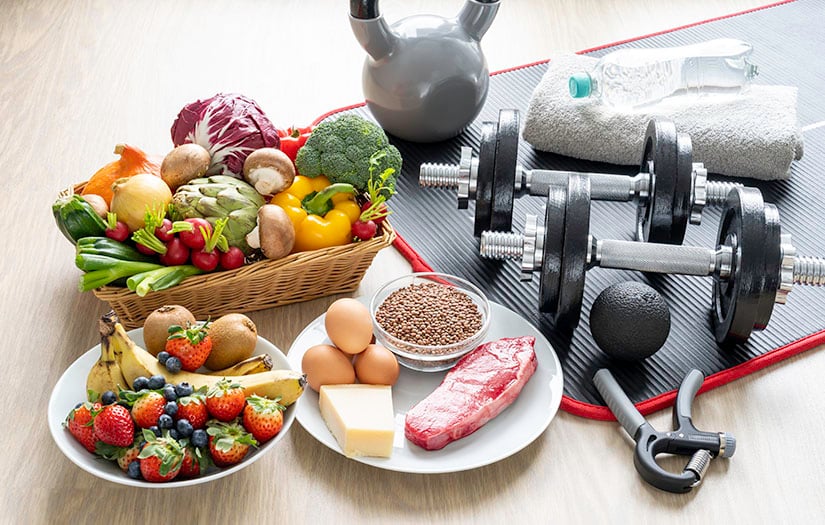Degrees in sports nutrition
The effects of low muscle glycogen on molecular markers of protein synthesis and myogenesis before and during aerobic exercise with carbohydrate ingestion is unclear https://funny2minutes.com. The purpose of this study was to determine…
Athletes have different religious and cultural backgrounds associated with certain customs, traditions, values, and beliefs, which are usually passed down from generation to generation and can influence their choice of food . For some athletes, family traditions and ethnic background do not matter much when choosing food, while for others, food choices based on religious beliefs are paramount . Indeed, long-standing customs may prevail over health and sport-recommendations recommendations in favor of the performance seen in heavy sports such as wrestling and horse racing . In general, cultural factors are important determinants of food choices and can be important for athletes.
The aim of this study was to investigate if the supplementation with Opuntia ficus-indica (OFI) juice may affect plasma redox balance and heart rate variability (HRV) parameters following a maximal effort test, i…
The amount and the type of protein and carbohydrate in a -personalized diet are critical to muscle growth and overall performance. Over the past years, there is significant progress in the understanding of the mechanism regulating gene expression and protein synthesis events, in the evaluation of genetic variations, and in how to figure out essential nutrients capable for activating such processes.

Degrees in sports nutrition
Goodson is a registered dietitian and consultant in the Dallas-Fort Worth area with an emphasis in overall health, wellness and sports nutrition. She has worked with the Dallas Cowboys, the Texas Rangers, TCU Athletics, FC Dallas Soccer, and many PGA Tour players. Goodson is the owner of RD Career Jumpstart, a business to help dietetic students and registered dietitians reach their dream career.
Students “learn by doing” through performance-based programming, which prepares practitioners to work with a wide variety of athletes. The department’s advanced labs and technology help students prepare for the real world. UT’s relationships with numerous local athletic teams allows students put their theories to test. UT faculty and students have also conducted extensive research with companies that are involved in exercise and nutrition/supplementation. These collaborations give students an insider’s view of the industry and provide a strong network for post-graduation jobs.
Our program equips you with the advanced knowledge, research skills, and practical applications needed to excel in the growing field of sports nutrition. Whether you aim to work with elite athletes, support recreational fitness enthusiasts, or advance into teaching and research roles, this degree can open the door to numerous opportunities in both the academic and professional worlds.
The sports nutrition program focuses on the application of nutrition principles as they relate to sport and human performance. Students will explore how nutrition impacts performance. Graduates will be prepared for careers including sports nutrition, personal training or work in the fitness industry, including product development and research. Students may choose to supplement their academic training with national certification in a specific area including personal trainer, strength and conditioning coach or health coach.
Applicants must satisfy the necessary prerequisites as prescribed for the Master of Science in Nutrition – Sport Nutrition. In some instances, leveling coursework may be required if undergraduate course transcripts do not provide sufficient evidence for successful mastery of cognitive and/or practical applied skills and abilities as related to the program. All leveling courses are taken online.
International society for sports nutrition
Interestingly, supplementation with 15 g of EAAs and 30 g of carbohydrate produced a greater anabolic effect (increase in net phenylalanine balance) than the ingestion of a mixed macronutrient meal, despite the fact that both interventions contained a similar dose of EAAs . Most importantly, the consumption of the supplement did not interfere with the normal anabolic response to the meal consumed three hours later . The results of these investigations suggest that protein supplement timing between the regular “three square meals a day” may provide an additive effect on net protein accretion due to a more frequent stimulation of MPS. Areta et al. were the first to examine the anabolic response in human skeletal muscle to various protein feeding strategies for a day after a single bout of resistance exercise. The researchers compared the anabolic responses of three different patterns of ingestion (a total of 80 g of protein) throughout a 12-h recovery period after resistance exercise. Using a group of healthy young adult males, the protein feeding strategies consisted of small pulsed (8 × 10 g), intermediate (4 × 20 g), or bolus (2 × 40 g) administration of whey protein over the 12-h measurement window. Results showed that the intermediate dosing (4 × 20 g) was superior for stimulating MPS for the 12-h experimental period. Specifically, the rates of myofibrillar protein synthesis were optimized throughout the day of recovery by the consumption of 20 g protein every three hours compared to large (2 × 40 g), less frequent servings or smaller but more frequent (8 × 10 g) patterns of protein intake . Previously, the effect of various protein feeding strategies on skeletal MPS during an entire day was unknown. This study provided novel information demonstrating that the regulation of MPS can be modulated by the timing and distribution of protein over 12 h after a single bout of resistance exercise. However, it should be noted that an 80 g dose of protein over a 12-h period is quite low.
Ingestion of carbohydrate + protein or EAAs during endurance and resistance exercise can help to maintain a favorable anabolic hormone profile, minimize increases in muscle damage, promote increases in muscle cross-sectional area, and increase time to exhaustion during prolonged running and cycling.
The effect of insulin on MPS is dependent on its ability to increase amino acid availability, which does not occur when insulin is systematically increased (e.g., following feeding) . In particular, insulin’s impact on net protein balance seems to operate most powerfully in an anti-catabolic manner on muscle . However, insulin-mediated effects that reduce muscle protein breakdown peaks at low to moderate levels of insulin (~15–30 μIU/mL) that can be achieved by consumption of a 45-g dose of whey protein isolate alone . Taken together, these results seem to indicate that post-workout carbohydrate supplementation offers very little contribution from a muscle development standpoint provided adequate protein is consumed. For example, Staples and colleagues compared the impact of a carbohydrate + protein combination on rates of MPS and reported no further increases in MPS beyond what was seen with protein ingestion alone. Importantly, these results are not to be interpreted to mean that carbohydrate administration offers no potential effect for an athlete engaging in moderate to high volumes of training, but rather that benefits derived from carbohydrate administration appear to more favorably impact aspects of muscle glycogen recovery as opposed to stimulating muscle protein accretion.
For the first three years of publication, the JISSN was published as a peer-reviewed open access electronic journal accessible through the ISSN’s website. While this format has been successful, the ISSN’s Board of Directors sought to increase the visibility, credibility, and impact of the JISSN. As a result, the ISSN decided to convert the JISSN from a society-based electronic journal to a BioMed Central journal. BioMed Central is an independent publishing house committed to ensuring peer-reviewed biomedical research is open access – immediately and permanently available online without charge or any other barriers to access. Publishing the JISSN through BioMed Central provides an automated online submission and peer-review process; publication preparation services; the ability to publish articles online within a few days of acceptance; and, automatic indexing through PubMed , PubMed Central , Scirus , Google , Citebase , and OAIster . Additionally, it allows for citation tracking through Thomson Scientific (ISI) which will help establish and build a strong impact factor for the JISSN. While there is an article-processing charge associated with publishing through BioMed Central, the ISSN Board of Directors believes that converting JISSN to a BioMed Central journal will make it more convenient for authors to submit their articles as well as greatly enhance the exposure and impact of articles published in the JISSN.

Interestingly, supplementation with 15 g of EAAs and 30 g of carbohydrate produced a greater anabolic effect (increase in net phenylalanine balance) than the ingestion of a mixed macronutrient meal, despite the fact that both interventions contained a similar dose of EAAs . Most importantly, the consumption of the supplement did not interfere with the normal anabolic response to the meal consumed three hours later . The results of these investigations suggest that protein supplement timing between the regular “three square meals a day” may provide an additive effect on net protein accretion due to a more frequent stimulation of MPS. Areta et al. were the first to examine the anabolic response in human skeletal muscle to various protein feeding strategies for a day after a single bout of resistance exercise. The researchers compared the anabolic responses of three different patterns of ingestion (a total of 80 g of protein) throughout a 12-h recovery period after resistance exercise. Using a group of healthy young adult males, the protein feeding strategies consisted of small pulsed (8 × 10 g), intermediate (4 × 20 g), or bolus (2 × 40 g) administration of whey protein over the 12-h measurement window. Results showed that the intermediate dosing (4 × 20 g) was superior for stimulating MPS for the 12-h experimental period. Specifically, the rates of myofibrillar protein synthesis were optimized throughout the day of recovery by the consumption of 20 g protein every three hours compared to large (2 × 40 g), less frequent servings or smaller but more frequent (8 × 10 g) patterns of protein intake . Previously, the effect of various protein feeding strategies on skeletal MPS during an entire day was unknown. This study provided novel information demonstrating that the regulation of MPS can be modulated by the timing and distribution of protein over 12 h after a single bout of resistance exercise. However, it should be noted that an 80 g dose of protein over a 12-h period is quite low.
Ingestion of carbohydrate + protein or EAAs during endurance and resistance exercise can help to maintain a favorable anabolic hormone profile, minimize increases in muscle damage, promote increases in muscle cross-sectional area, and increase time to exhaustion during prolonged running and cycling.
Supplement sports nutrition
There are many top sports nutrition products that will get the job done: Three of the best protein powder brands are BioSteel, Optimum Nutrition, and Garden of Life. The price for protein powder varies depending on the size and type you buy. On average, you’ll spend $30 to $60 for a tub of protein powder that can last a month.
No, most supplements for athletes aren’t expensive, but prices vary. Vitamins from the drugstore can cost less than $10 for a month’s supply. Supplements with additional nutrients for athletes will cost more, often ranging from $30 to $100 for a month’s worth.
There are no side effects connected to BCAAs. However, BCAAs studies’ results vary, so ensure you’re informed before taking this supplement. There’s also no general suggestion for dosage, so check the label of the supplement you buy.
Since ashwagandha is an herb, there aren’t the same risks of side effects as there are with steroids or other speed supplements, so it’s safe to try. Take at least 300mg of ashwagandha twice a day for optimal benefits. After 8 to 12 weeks, you’ll notice an increase in your oxygen intake and overall physical health.
Jones is a nationally recognized and award-winning registered dietitian nutritionist, nutrition communications consultant and owner of Lisa Jones LIVE. She is a professional speaker and author who specializes in fueling messages with humor to connect, motivate and educate. Jones has more than two decades of experience, and specializes in lifestyle nutrition, family nutrition and kidney nutrition.
